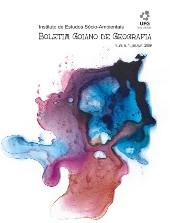IDENTIFICAÇÃO DE ILHAS DE CALOR POR MEIO DE SENSORIAMENTO REMOTO: ESTUDO DE CASO NO MUNICÍPIO DE GOIÂNIA – GO/2001 - DOI 10.5216/bgg.v29i1.7112
DOI:
https://doi.org/10.5216/bgg.v29i1.7112Resumo
No presente trabalho são utilizadas técnicas de sensoriamento remoto para análise e identificação do fenômeno de ilhas de calor em Goiânia-GO, TENDO como recorte temporal o ano de 2001. Foi utilizada uma proposta metodológica de Monteiro (1976), do Sistema de Clima Urbano - SCU, em especial o subsistema Termodinâmico, visando proceder uma uma análise do Funcionamento, desempenho e organização do fenômeno de ilhas de calor. A elaboração do trabalho baseou-se na classificação da cobertura do solo e em um mapeamento do campo térmico do Município de Goiânia, por meio das imagens das bandas 3, 4, 5 e 6 (banda termal) do Landsat 7, nas Quais Foram Considerados como instrumentos de análise: a urbanização, geoecológicas características como (topografia) eo sistema meteorológico (clima regional). Os resultados demonstram que o fenômeno de ilha de calor é constatado no município de Goiânia, havendo diferenças de temperatura de até 10 ° C entre uma área urbana ea rural do Município, sendo Possível caracterizar DETERMINADOS usos antrópicos (classes de cobertura do solo) e intervalos altimétricos como Potencializadores de maiores valores de temperatura.











